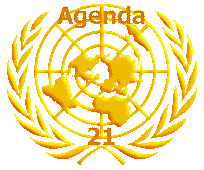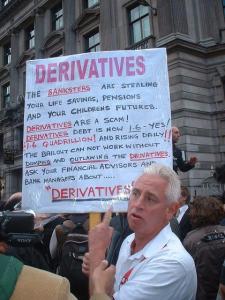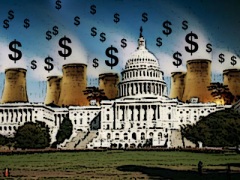Agenda 21, Biodiversity and Land Theft
June 28, 2010
Cassandra Anderson
The true facts of life are that the globalist control freaks have caused environmental disasters in order to implement their
solutions, which are even worse. And they get public support through lies, government regulations and our tax dollars. UN Agenda 21 Sustainable Development is the overarching blueprint for depopulation and control using the environment as the excuse. See the complete globalist chart by clicking here.
Last month the UN announced that they were shifting their focus from global warming (which has been thoroughly discredited) to biodiversity, which is really a way to steal land by way of the Endangered Species Act. In fact, a new UN agency has been created to monitor biodiversity (Intergovernmental Science Policy Platform on Biodiversity and Ecosystem Services or IPBES), and is based on the UN’s fraudulent IPCC. The new fear that is being created is the destruction of habitats and species resulting from human activity.(1)
These videos by Dr. Michael Coffman explain the impact of the Endangered Species Act:
The Birds
Have you wondered why BP Oil used Corexit in the Gulf? There is evidence that the motive was to kill as many birds and sea creatures as possible to usher in the expansion of the Endangered Species Act (ESA) in addition to the $40 million in profits for NALCO (Corexit manufacturer) and the motive of submerging the oil from public view. There are numerous non-toxic alternatives to Corexit, which are still ignored by the EPA. The ESA will be used as a weapon to prevent further drilling and America’s energy independence. It is falsely being sold as the way to avoid future catastrophes and because most people love animals, they will be easily fooled.(2)
Have you noticed that environmental groups are far less concerned with taking effective action in pressuring BP Oil, Obama and Congress to stop and the spill, and are instead filing lawsuits to stop drilling and promote inefficient solar and wind energy? The environmental groups’ lack of action against BP Oil and the EPA is glaring. Instead, they are pursuing the expansion of governmental regulations by way of the ESA. Most environmental groups, and certainly the big ones like WWF, Greenpeace, NRDC and the Sierra Club, are controlled opposition. They are funded by your tax dollars, oil companies, the UN and foundations like the Rockefeller and Ford foundation.(3)
The attention to migratory birds is important because they do cross state lines, so the federal Department of Commerce then sticks its beak where it doesn’t belong. There is no provision in the Constitution for federal oversight of wildlife.
The ESA was passed into law through 5 international treaties, the first one was the Migratory Bird Act. When this treaty was challenged in the Supreme Court (Missouri v. Holland), the ruling was against the 10th Amendment state sovereignty. The Supremacy Clause was weakened when the Migratory Bird Act treaty was decided to supersede the Constitution, thereby opening the door for treaties to be superior to the Constitution, in complete opposition to the Founding Fathers intentions. Many have tried to get the Supreme Court to clarify the Supremacy Clause and for Congress to limit the distorted interpretation, but have failed. ANd now we have thousands of treaties with foreign governments through the UN.
The Bees
American bee populations are dwindling and most evidence points to pesticides as the primary culprit; remember that GMO crops were made to withstand large amounts of pesticides and herbicides. It only makes sense that harmful pesticides should be taken off of the market. The most direct route to accomplish this is to sue the manufacturers and the EPA for approving numerous harmful pesticides. However, there are only a handful of lawsuits compared to the numerous pesticide products that are available. Instead, environmental groups seek to expand regulations that prevent economic development via the ESA.(4)
The Xerces Society for Invertebrate Conservation filed a petition to put Franklin bumble bees on the Endangered Species List. The problem with this is that when a species is considered ‘endangered’ their habitat, which is most often private property (farms, ranches, businesses and homes), has severe restrictions placed on it by the federal government. If these bees are found to be ‘endangered’, it opens the door to placing other bees on the Endangered Species list. Imagine the scope of habitat for bees. If environmental disasters are planned, and there is evidence for this (the lack of action and oversight regarding dangerous chemicals and the cozy relationship between government and industry), then using bees, whose habitat is everywhere, is truly diabolical.
Because environmental groups are funded by globalists, corporations and governments whose goal is to lock down and restrict land use as well as expanding government control, the environmental groups do the bidding of these entities, under the banner of saving the planet. The Xerces Society is funded by many federal government agencies including the EPA, the Department of Interior (they have jurisdiction over Endangered Species) and the USDA as well as other environmental UN NGOs (non governmental organizations) and the Turner Foundation. It obvious that these environmental agencies are loyal to the parties that finance them.(5)
The Endangered Species Act
Perhaps the biggest example of globalist control through ESA is the Congress caused drought in the Central Valley of California that is the breadbasket of America. Because the Delta smelt and salmon populations were declining, the irrigation water to farms was cut. This was a poor solution because the fish populations continued to decline for 3 years despite the water restrictions. It was later revealed that pollution in the Delta was the cause of the fish decline, caused by up to one billion gallons of partially treated sewage being flushed into the Delta daily. Of course, the principled scientist who went public with this information was maligned because she exposed the bad science that is commonly practiced when a political policy is involved.
Top 5 reasons the ESA is bad:
1. It doesn’t work! Severe restrictions on landowners do not result in increased population. Of the 60 species that have been de-listed, NONE of them were removed because of the imposed controls.(6)
2. Bad and fraudulent science is used because the ESA is really just a vehicle for control through public policy. In fact, some federal and state agents were actually found to have planted Canadian Lynx fur outside of a range, in order to increase the habitat range. And their power.(7)
3. The 5th Amendment is violated, as there is no “due process’ or compensations to landowners for extremely harsh restrictions.
4. The ESA chips away at State sovereignty- there is no provision in the Constitution that gives the federal government power over wildlife it is the states’ jurisdiction. The federal government uses the ESA to usurp ower.
5. Bill Clinton’s ‘Gap Analysis’ (a study that detailed how much of American land is privately owned) is targeted at private property owners for takeover.
Solutions
• When junk science is discredited, the lies unravel. This is the most effective method to get rid of bad policies, like the water restrictions in California and fallout from Climategate. When the people don’t respect the authorities, they lose power. It is necessary for the masses to become extremely skeptical of science that is associated in any way with policymaking. Phony environmentalism must be exposed.
• States can assert their 10th Amendment powers and tell the federal government to buzz off.
• Local governments have a tremendous amount of power regarding the ESA, through building permits and law enforcement.
For example, in Iron County, Utah, the federal government claims that prairie dogs are ‘endangered’. It is not true. This is a ploy to limit farming and other economic development. Every time a prairie dog is killed by a tractor on a farm, the sheriff is expected to investigate; there is only a limited number of prairie dog deaths allowed, or the farm can be shut down. Further, if someone owns property and wants to build, they will be refused a building permit if prairie dogs are found on the property. Building permits are issued through the county, so it is under the jurisdiction of the County Commissioners or Supervisors.
It is imperative that state and county governments learn about the abuse of power by the federal government because the economy and our freedom are at stake.
To learn more about how the federal government plans to steal your land, watch the excellent flash presentation by Dr. Michael Coffman, “Taking Liberty”.(8)
Dr. Michael Coffman’s Environmental Perspectives website address is www.epi-us.com.
Please visit Cassandra Anderson’s website at www.MorphCity.com.
Sources:
1. http://www.guardian.co.uk/environment/2010/jun/11/un-ipcc-for-nature-biodiversity
2. http://www.wired.com/wiredscience/2010/06/esa-overhaul/
3. http://www.morphcity.com/home/75-food-and-depopulation-part-4-of-4
4. http://www.naturalnews.com/027971_pesticides_bees.html
5. http://lib.store.yahoo.net/lib/realityzone/UFNxercesbeefunders.html
6. http://www.newswithviews.com/Coffman/mike2.htm
7. http://www.morphcity.com/agenda-21/environment/esa
8. http://www.takingliberty.us/TLHome.html




